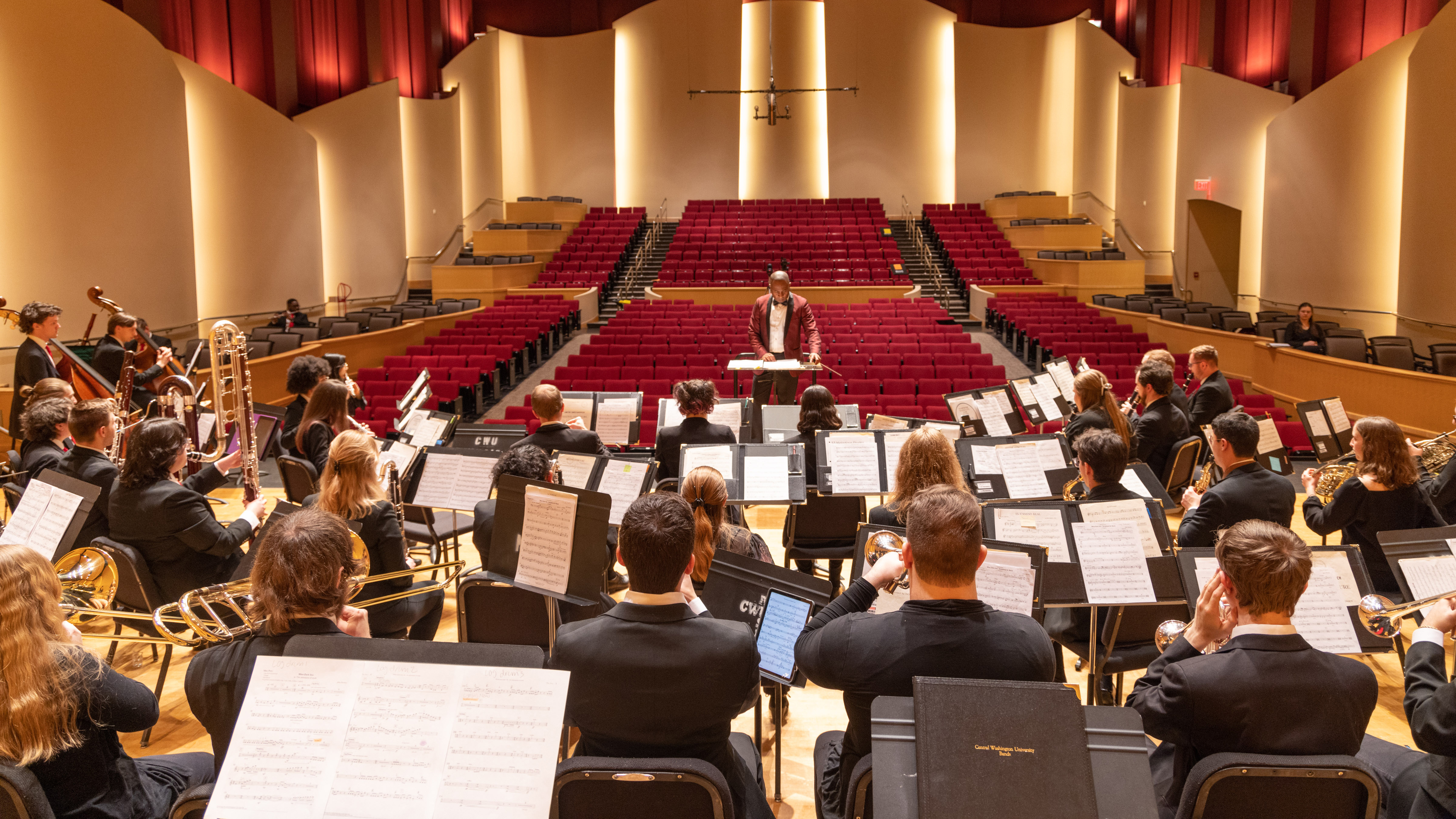
Music
Transfer Theory Diagnostic Exam
Transfer Student Information
In addition to general education courses, transfer students wanting to major in music at CWU should have completed two years of Music Theory (Written and Aural Skills), Two years of Applied lessons on a major instrument or voice, and also developed basic piano skills (if piano is not your major instrument). If you do not have any courses in these areas, then you will begin at the first year level as a music major at CWU. Yes, you will be a freshman and it will take a minimum of four years to complete your music degree. If you are a transfer student, but have yet to take any theory courses. follow the incoming freshman instructions found on our Freshman Theory Fundamentals Exam page.
Otherwise, we are happy to give you credit for theory courses taken at other institutions. However, we want to be sure your knowledge and skills are on a par with the students who have gone through our theory sequence. Use the guide below to help prepare for our transfer student theory diagnostic exam.
Transfer Student Study Guide
This guide is meant to help undergraduate transfer students prepare for the Music Theory Diagnostic Evaluation exam. This evaluation is meant to ensure students have competence in theory and analysis at the undergraduate level. There are two parts to the exam: aural and written. Each part is set up according to the content of the six quarter theory sequence. Students will be placed in the appropriate quarter according to their skill level as demonstrated on this exam. Questions should be directed to Dr. Jiyoun Chung.
Part One: Aural
Ear Training/Dictation:
- Scales
- Melodic and harmonic interval identification
- Triads and Seventh Chords in root position
- Cadence types
- Triads in root position and inversions
- Dominant Seventh Chords in inversions
- Augmented sixth chords
- Extended Dominants
- Modes and Synthetic Scales
- Simple and Compound rhythms
- Identification of Short Harmonic Progressions
- One Part Melodic dictation with chromaticism
- Two-part melodic dictation, notate one voice in treble and one voice in bass clef
- Four-part harmonic dictation, notate soprano and bass voices and supply a Roman numeral/figured bass analysis
Part Two: Written
Theory, 1st Quarter
- Barlines
- Time Signatures
- Key Signatures
- Scale degree names and numbers
- Solfege syllables using movable do
- Intervals
- Inversions of Intervals
- Diatonic Roman Numeral Analysis
Theory, 2nd Quarter
- SATB Part writing (Voice leading rules)
- Spelling Seventh Chords
- Roman numeral Analysis with seventh chords
- Cadence Types
- 6/4 Chords (Passing, Pedal, Cadential) – Correct Resolutions
- Figured bass
- Theory, 3rd Quarter
- Resolving Dominant sevenths
- Embellishing Tones (Passing, Neighbor, Anticipation, Escape Tones, Appoggiatura, Pedal)
- Suspensioning (Preparation – Suspension – Resolution)
- Analysis including embellishing tones and seventh chords
- Harmonizing soprano lines
- Analysis of Piano excerpts
Theory, 4th Quarter
- Key Relationships (Relative, Parallel, Foreign, Closely Related, Enharmonic)
- Secondary Dominants and Secondary Leading Tone Chords
- Figured Bass with Secondary Chords
- Modulations (Common Chord, Chromatic, Phrase)
- Forms (Binary, Rounded Binary, Ternary, Composite Ternary, Rondo, Sonata Form)
- Theory, 5th Quarter
- Borrowed Chords (Mode Mixture)
- Neapolitan Chords and Augmented 6th Chords
- Enharmonic Modulations
- Popular Chord Symbols
- Chromatic Mediants
- Extended Dominants
- Altered Dominants
Theory, 6th Quarter
- Late Romantic Techniques
- Diatonic Modes, Pentatonic and Synthetic Scales
- Rhythmic Devices Syncopation, Asymmetrical Meters, mixed meters, additive rhythms, polyrhythm, polymeter, ametric, added values, non-retrogradable rhythms, metric modulations
- 20th Century Concepts quartal/quintal, secundal/tone clusters, parallelism/planing, polytonality, extended harmonies, chord succession, pandiatonicism, atonality
- Post-Tonal Theory 12-tone Method, Matrix, Prime, Retrograde, Inversion, Retrograde Inversion, hexachordal combinatoriality, pitch class set, prime form, best normal order, inversionally/transpositionally symmetrical
- 20th/21st Century Styles/Concepts Primitivism, Neoclassicism, Serialism, Sprechstimme, Pointillism, Prepared Piano, Aleatoric, Minimalism, Total Serialism
Additional Information
Your registration for other music courses, including applied music (private lessons), will be in jeopardy if you do not take this exam. If you have questions about this, address them to Dr. Kirsten Boldt-Neurohr.
The results of this exam will help place the student in the appropriate class within the theory sequence. It will also help ensure that the student is successful and that they complete their chosen music degree program with the appropriate level of content knowledge. The theory curriculum is an integrated and comprehensive program including ear-training skills, melodic/harmonic/rhythmic dictation, solfege and extensive sight-singing skills, keyboard harmony, and extensive written content from fundamental skills through an introduction to post-tonal techniques. Content covered during each quarter can be found in the current course syllabi on the “Music Theory Courses Offered” page.
Dr. Kirsten Boldt-Neurohr
Advising & Recruiting Specialist
Kirsten.Boldt-Neurohr@cwu.edu
CWU News

CWU Student Fashion Association visits New York to network with industry leaders
April 29, 2024
by Rune Torgersen

NESSP to host challenge day at CWU for NASA Artemis ROADS II teams
April 29, 2024
by Darci Snowden